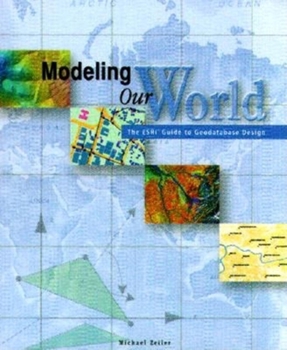Modeling Our World: The ESRI Guide to Geodatabase Design
Select Format
Select Condition 
Book Overview
Geographic data models are digital frameworks that describe the location and characteristics of things in the world around us. With a geographic information system, we can use these models as lenses... This description may be from another edition of this product.
Format:Paperback
Language:English
ISBN:1879102625
ISBN13:9781879102620
Release Date:January 2000
Publisher:Esri Press
Length:200 Pages
Weight:1.35 lbs.
Dimensions:0.5" x 7.5" x 9.1"
Customer Reviews
5 ratings
ESRI Geodatabase design concepts
Published by Thriftbooks.com User , 18 years ago
This book gives an overview of the geodatabase CONCEPTS in ESRI's ArcGIS 8.3 and above. This is not a "how-to" guide, but introduces geodatabases and the ubiquitous Unified Modeling Language (UML) diagrams. Readers are at least introduced to the functionality and displays in ArcCatalog and layers. For those just used to simple maps, the concepts of surface modeling with triangulated irregular networks (TIN), geographic networks and flow, and raster data sets were introduced. For one coming to the geographic databases by way of traditional databases, the concepts of adding attributes to relationships may have been too lightly covered. Additionally the concepts of subtypes (versus attribute domains) to define behavior to different classification of your data was new and useful. The topological operators are introduced, but the rich set of topological rules is barely introduced. Although ArcGis map versioning and workflow some of the concepts of enterprise GIS (as manifest in ArcIMS products and SDE) were not introduced. Those desiring a how-to guide, would be well served after reading this book to take the ESRI online class "Creating, Editing, and Managing Geodatabases for ArcGIS 9" which has exercises and examples.
as described
Published by Thriftbooks.com User , 18 years ago
product was exactly what I ordered in excellent condition at a very good price.
It is a reference.
Published by Thriftbooks.com User , 19 years ago
If you want to learn this much GIS terminology, you have to read hundereds of pages of ESRI's guide or reference books. This is an excellent reference in GIS literature that introduces hundereds of terms in a reasonable size and good price. The author went to the very corners of GIS-data-base structure. For any GIS-term you can find an illustration and explanation. The text is clearly written by an ArcInfo User that is some how "heavy". However,as an ArcGIS/ArcView user it was useful for me. The book title is somehow misleading at the first glance, but when you go inside, you can see no other title can fit this topic. BUY IT, if you want to know the GIS terminology to the extreme details, including backgrounds, comparative explanations and so on. DON'T BUY IT, if you want to do GIS modelling buy reading this book, as the text is mostly concentrates on data base.
Zeiler knows GIS
Published by Thriftbooks.com User , 23 years ago
This book works very well for people new to GIS as well as experienced users. The fundamentally important concepts to GIS are explained both generally as well as from within the perspective of the new ESRI ArcInfo 8 software. Difficult and new concepts such as versioning, geometric networks, and raster imagery are particularly well explained. The book is not a software user manual, but rather an explanation of the fundamental GIS concepts, particularly those important to the new Geodatabase.The book is a veritable corucopia of colorful graphics, figures, and imagery. Many readers will be able to achieve an 80% understanding of the material merely by closely studying the figures and examples - kind of the National Geographic "read the captions" approach. The text contains lots of class/component diagrams that give a very good overview of the underlaying Geodatabase software architecture. This is a book that I will use and refer back to on a frequent basis. Rock on!
GIS Concepts that everyone can understand
Published by Thriftbooks.com User , 24 years ago
Admittedly this is an ESRI perspective of modeling. But as the leaders in the field of GIS software, the ESRI perspective is the accepted standard. This book does an excellent job of explaining most of the basic concepts that are used in GIS. Terms like TIN and raster are better explained in this book then anywhere else that I have seen. Too often a GIS textbook tries to explain visual concepts with a few black and white diagrams. Not here, the graphics are colorful and very well integrated with the descriptions. This book is where anyone interested in GIS should start. It is a must have for anyone teaching or studying GIS.




